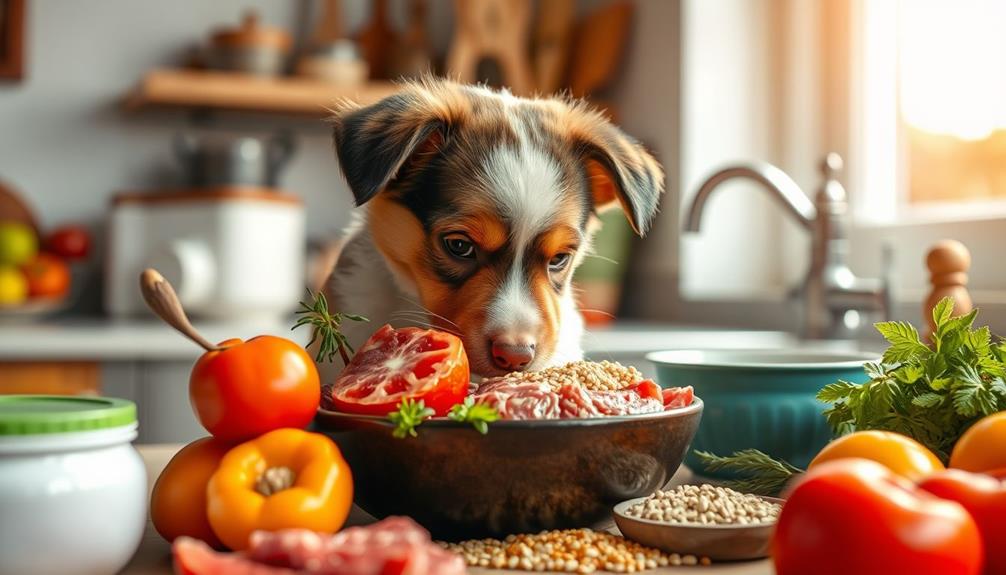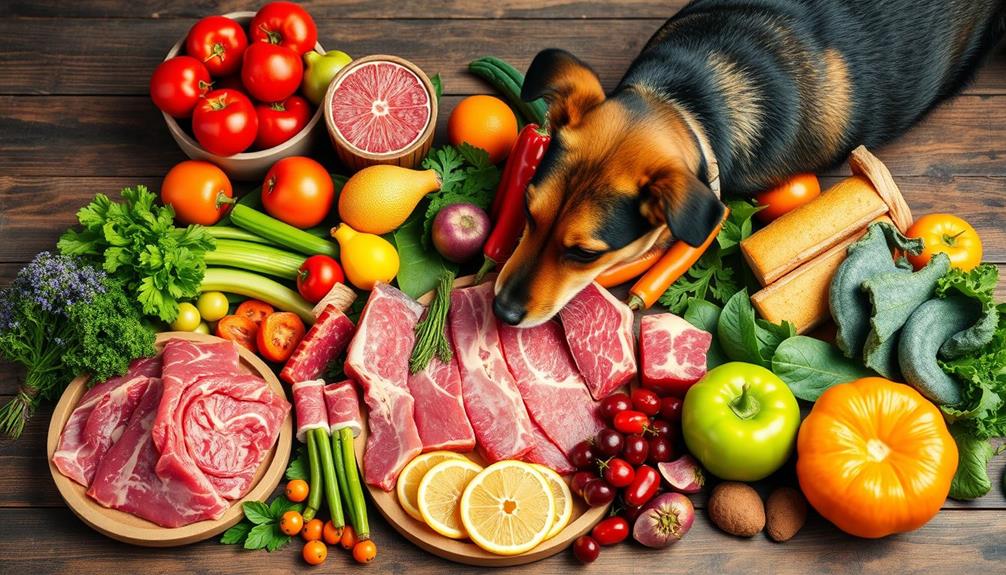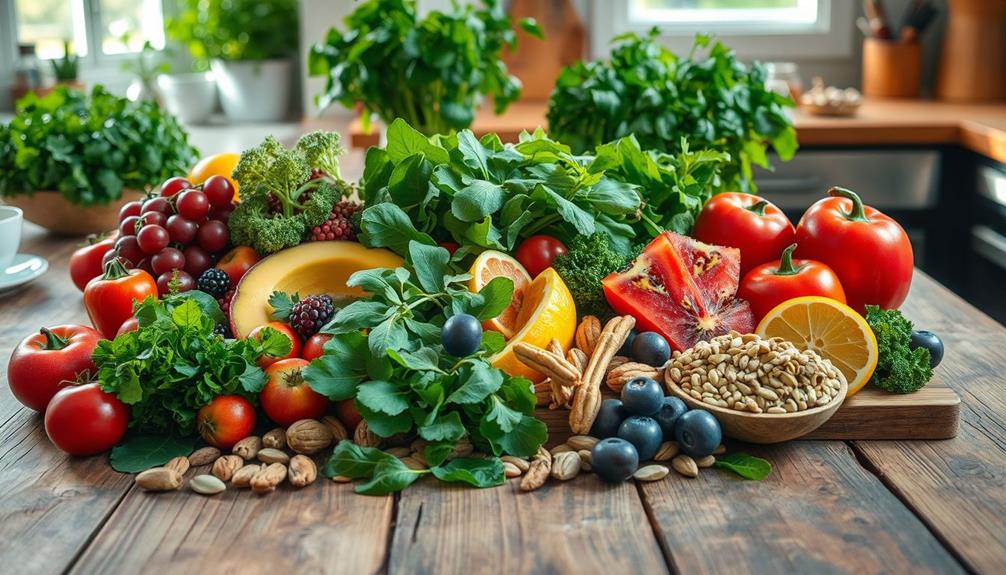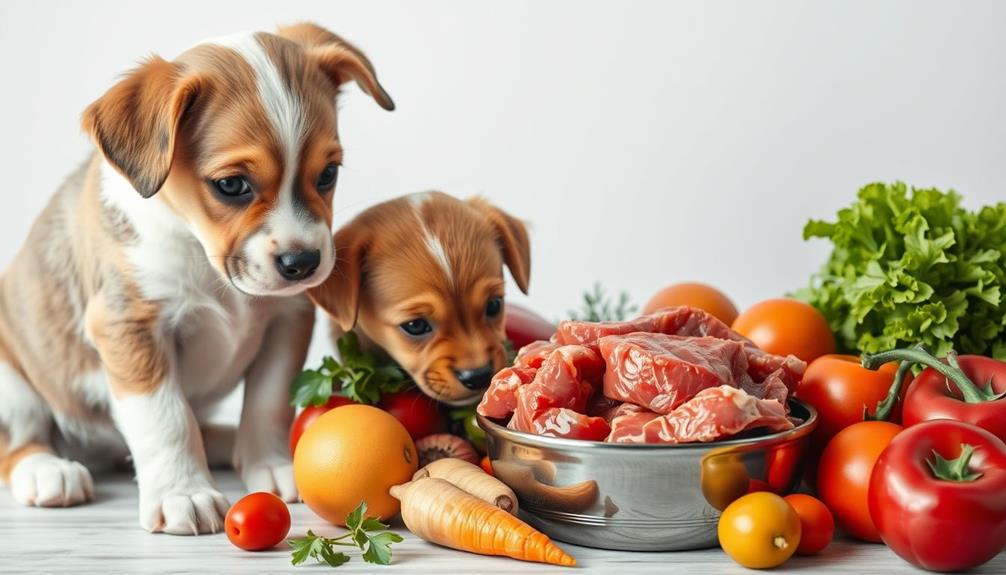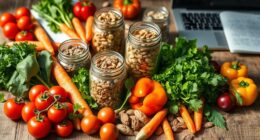Yes, it's generally okay to mix raw food with kibble, as this can boost your dog's nutrition. Just make sure to introduce the raw food gradually over about four to six days to avoid any digestive issues. Dogs can effectively digest both types of food together, thanks to their highly acidic stomachs and digestive enzymes. Aim for a balanced ratio, such as 10-25% raw food, which may enhance nutrient absorption and overall health. Always monitor your dog's reaction during the change. Curious about how to choose the right raw food options? There's more to evaluate.
Key Takeaways
- Gradual introduction of raw food over 4-6 days helps dogs adapt without digestive stress.
- Mixing raw food with kibble can enhance nutrient absorption and overall health benefits.
- Dogs can efficiently digest diverse food types due to their highly acidic stomachs.
- Monitoring your dog's reaction during the transition is crucial for identifying any issues.
- Consulting with a veterinarian ensures the mixed diet aligns with your dog's specific health needs.
Myths About Mixing Raw and Kibble
When it comes to mixing raw food with kibble, many myths can cloud your judgment. One common myth is that mixing raw and kibble causes digestive problems. However, dogs can actually digest both types of food together effectively when you introduce the raw gradually.
Additionally, incorporating certain essential oils for digestive support can further promote a healthy digestive system. Another misconception is that this mix raises the pH of the stomach, but dogs have highly acidic stomachs that can handle various food types without significant risks.
Concerns about bacteria growth from mixing raw and kibble are largely unfounded. By practicing proper food handling and making gradual dietary changes, you can mitigate these risks.
It's also often thought that kibble and raw food are too different to digest simultaneously. In reality, studies show that digestive enzymes break down both food types effectively.
The notion that dogs shouldn't consume raw and kibble together overlooks the historical precedent of mixed diets. When done correctly, combining these diets can provide health benefits and nutritional variety.
Digestion and Nutritional Benefits
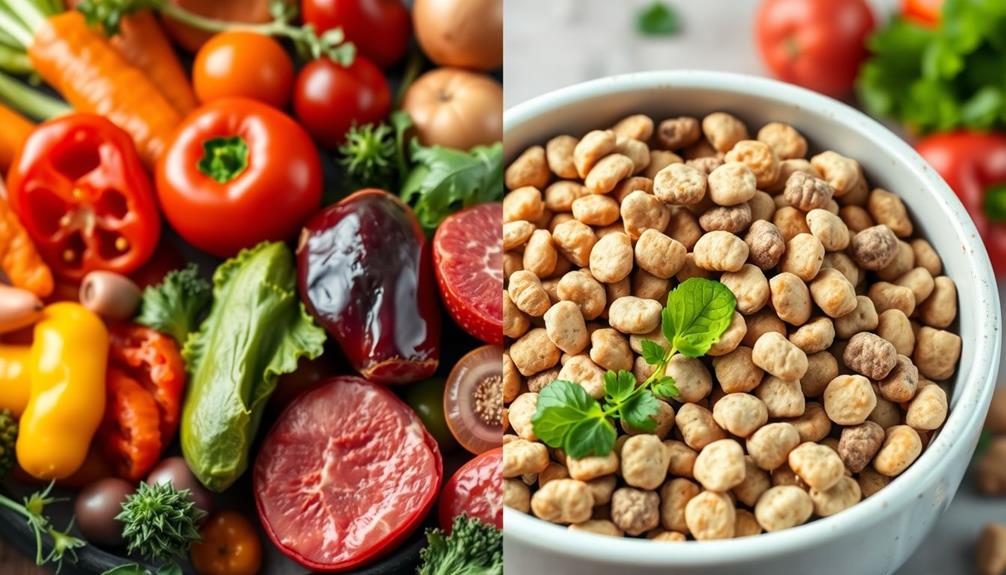
Mixing raw food with kibble can greatly boost your dog's digestion and overall nutritional intake. By incorporating raw food into your dog's diet, you can enhance nutrient absorption, leading to better health outcomes.
Dogs' digestive systems are designed to handle diverse food types simultaneously, which means that mixing can improve their digestive efficiency. A well-rounded diet, similar to what's suggested in pet care guidelines, can provide essential nutrients for ideal health. Additionally, ensuring a balanced diet is essential for maintaining a pet's energy and well-being, as proper diet includes fresh fruits, vegetables, and high-quality pellets.
A diet that includes even 10-25% raw food has been linked to better digestion and reduced allergies. Raw food typically offers higher moisture, fats, and proteins, which complements the lower moisture content of kibble. This combination leads to a more balanced nutrient intake, promoting ideal health.
Moreover, the gastrointestinal tract processes both raw food and kibble similarly after chewing, ensuring effective nutrient breakdown. Gradually introducing raw food can also stimulate a healthier gut microbiome, which plays a key role in improving digestive function and immune response.
Transitioning to a Mixed Diet
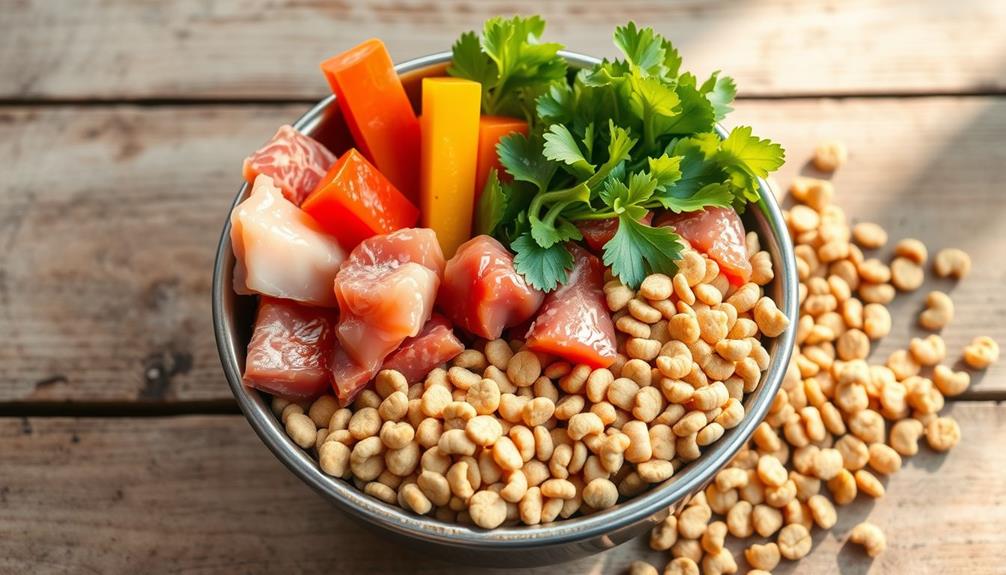
Successfully shifting your dog to a mixed diet of raw food and kibble can enhance their overall health and digestion. Start by gradually introducing raw food into their diet over 4-6 days, as this method allows the digestive system to adjust without causing stress.
This slow change helps prevent digestive upset, allowing gut bacteria to adapt to the new food source. During this adjustment period, aim for a 50/50 ratio of raw food to kibble by day six. Incorporating raw food can also improve your dog's nutrient intake and overall well-being, as seen in some studies on nutrition for health benefits.
Using raw food as a topper or base can make mixing raw dog food easier, facilitating smoother adaptation. It's essential to monitor your dog's reaction during this time. Watch for any signs of discomfort, as this will help you identify any adverse effects and adjust the diet accordingly.
Consulting with a veterinarian can provide you with tailored advice to guarantee a successful change. They can guide you on the best practices for mixing kibble and raw food, considering your dog's unique needs.
Practical Considerations for Mixing
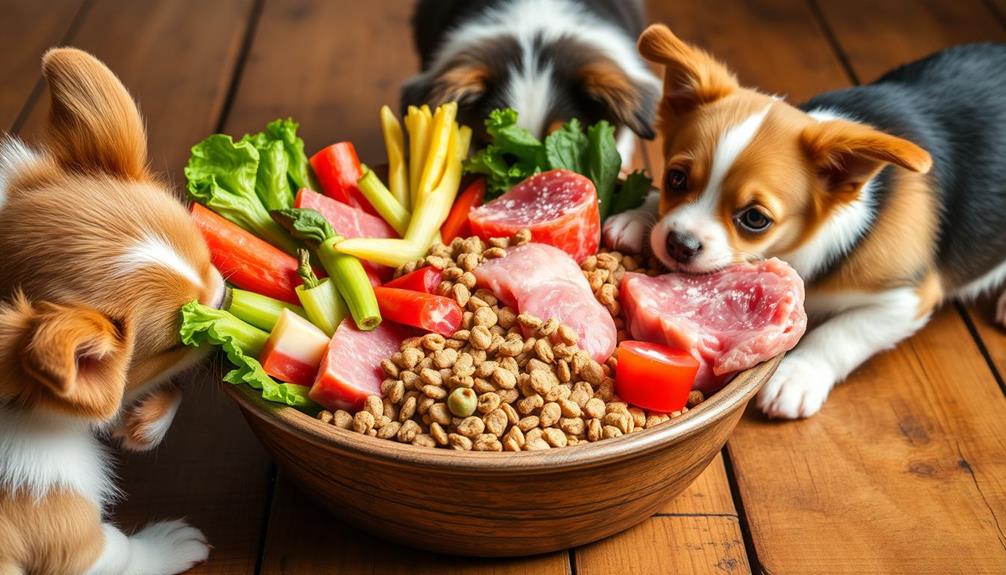
Establishing a practical approach to mixing raw food with kibble can make the shift smoother for both you and your dog. Start with a gradual introduction to prevent digestive issues; this allows your dog's gut bacteria to adjust properly. Offering healthy dog snacks can also be a great way to introduce new flavors and textures during the changeover.
Flexibility in your feeding schedule is key—consider serving kibble in the morning and raw food in the evening. This way, you accommodate your routine while meeting your dog's needs.
As you changeover, regularly monitor your dog's health and digestion to guarantee the mixed diet is beneficial. If you notice any adverse reactions, address them promptly. Mixing raw dog food with kibble can also be a cost-effective strategy, especially for households with multiple pets, allowing you to extend the raw food supply while providing nutritional variety.
Before making significant changes to your dog's diet, it's wise to seek veterinary consultation. This guarantees your approach aligns with your dog's specific health requirements and dietary needs.
Selecting Raw Dog Food Options
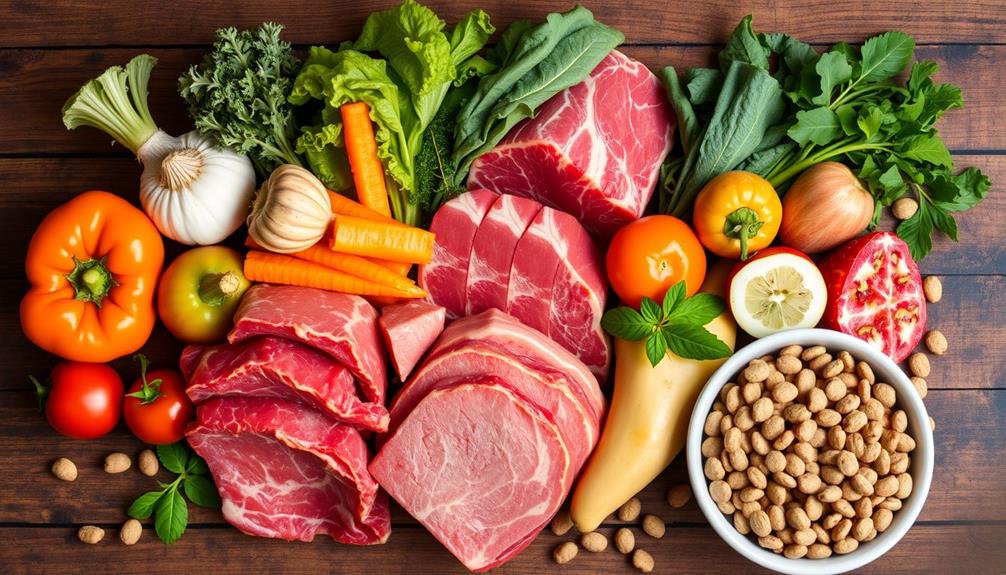
When you're selecting raw dog food options, it's vital to prioritize high-quality ingredients from reputable suppliers to guarantee your dog gets the best nutrition and safety.
Look for brands that offer complete and balanced meals, making sure they contain a healthy mix of proteins, fats, and necessary nutrients for peak health. This focus on nutritional value will help your dog thrive.
Additionally, consider the potential health risks of mixing certain foods, as some human food options can be harmful to pets; for instance, ice cream can pose risks to dogs due to lactose intolerance.
While comparing costs among different raw dog food brands, keep in mind that prices can vary considerably. Finding options that fit your budget while still meeting your dog's nutritional needs is vital.
Consider opting for portion-controlled meals, as they can simplify feeding routines and minimize the risk of overfeeding.
Additionally, subscription services for raw dog food can enhance dietary diversity and guarantee you receive fresh meals regularly. This convenience not only makes it easier to maintain a consistent feeding schedule but also helps you explore various proteins and ingredients, keeping your dog's diet interesting and nutritious.
Frequently Asked Questions
Is It Okay to Mix Raw and Kibble?
You can mix raw food with kibble, but it's wise to do so gradually. Monitor your dog's reactions, and consult your vet to guarantee this combination meets their nutritional needs and supports their health effectively. Mixing kibble with raw food can provide a variety of textures and flavors for your dog, making mealtime more interesting for them. It can also ensure that they are getting a well-rounded diet that includes both the convenience of kibble and the benefits of raw food. However, it’s important to do your research and work closely with your vet to ensure that you are making the best choices for your individual dog’s needs.
What Raw Food Can You Add to Kibble?
You can add raw meat, organ meats, or raw eggs to kibble for extra protein. Vegetables like carrots and spinach also enhance nutrition. Just start slowly to help your dog's digestive system adjust safely.
Can I Mix Fresh Pet Food With Dry Food?
You might've noticed your dog loves fresh food. Mixing it with dry food can enhance their diet, but introduce it slowly over several days. Always watch for any digestive changes and consult your vet for guidance.
What Can I Mix With Raw Dog Food?
You can mix raw dog food with fresh vegetables, fruits, or cooked grains for added nutrition. Including plain yogurt or probiotics can boost gut health. Just remember to introduce new foods gradually to avoid digestive issues.
Conclusion
Mixing raw food with kibble can feel like releasing a culinary revolution in your dog's bowl! Imagine gourmet meals colliding with crunchy kibble, creating a flavor explosion that sends your pup into a tailspin of joy. While the mix can provide nutritional benefits, it's essential to navigate this culinary adventure carefully. Embrace the journey of shifting and selecting the best raw options, and watch your dog thrive like a superstar in a food festival!



